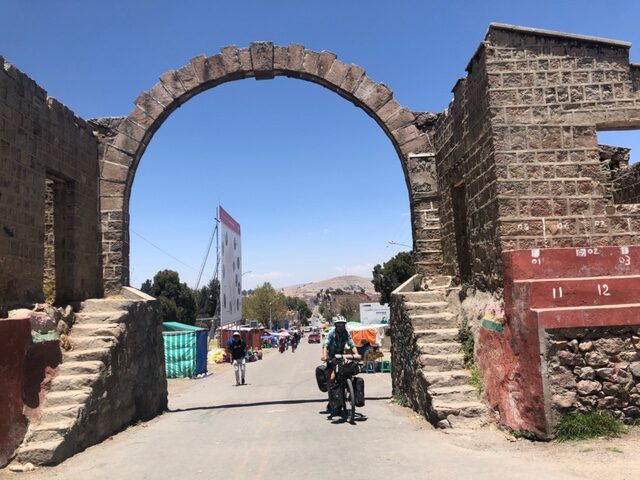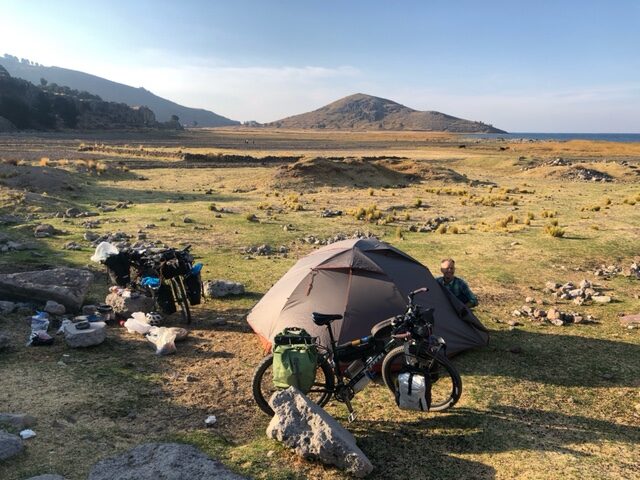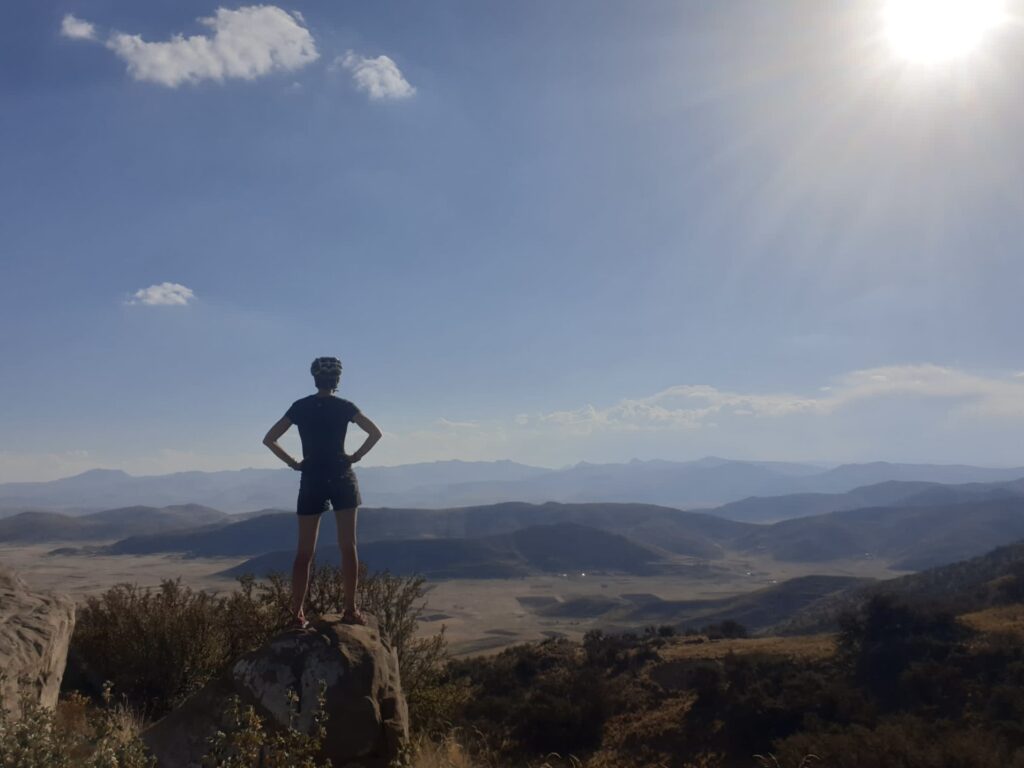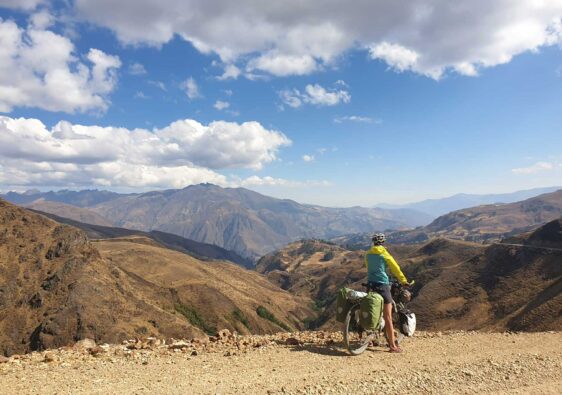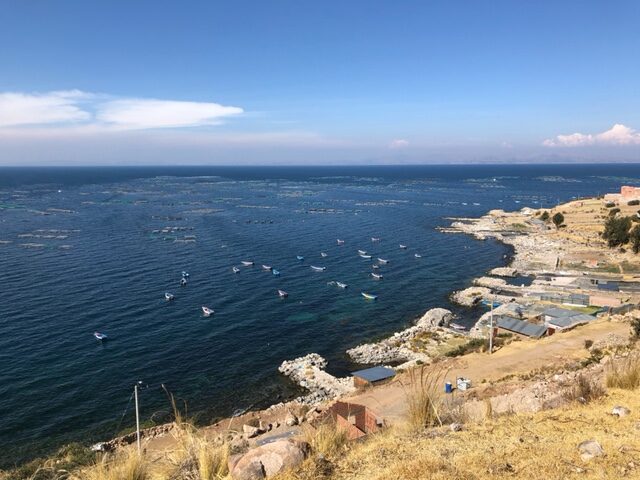
I’m sitting in one of the many beautiful courtyards in Cusco, Peru, enjoying the morning sun with a coffee. After almost three weeks in the stunning high altitude mountains it’s feels really good to stop and relax. Although easier said than done, when you’ve been going for so long it’s not that easy to unwind! But we’re on day five now and I finally feel like it’s ok to stop.
We’re staying in a quirky Airbnb at the top of a very steep cobbled street near the Inkan historical site, Saqsaywahmen, with great views over the city. When you’ve spent so many nights squashed in a tent, you really do appreciate having a two bedroom apartment with a courtyard to relax in. The same goes with food, up in the mountains it’s difficult to get hold of a variety of fruit and veg and so it feels so good to eat a variety of healthy, wholesome food. I notice these small pleasures all the more, just like I notice the warmth of the morning sun and the sound of birdsong. It’s not easy being constantly transient!

I have my first haircut in 6 months, i can’t get away with it anymore but I’m also terrified as my lack of Spanish might be the difference between me getting a trim and a grade 1 Sigourney Weaver style haircut! Fortunately it goes ok and I come out with a trim! I also hear the sad news my friends mum has died. I feel helpless and wish I could be there to support her. It also brings back memories for me.
After a week it’s time to leave. I could easily stay here longer but I feel the longer we stay the harder it will be to leave. I feel like I’ve put some roots down here, it feels good to settle, and the thought of picking these up and dragging them back onto the saddle is hard work. I know it will be ok once we’re going but it’s the first few peddles that are the hardest!

We do eventually get going, or at least we freewheel down the steep cobbled street to our favourite coffee shop for one last nice tasting coffee and chocolate brownie before heading south through the bustling city, our sights now on Bolivia. It should take us around seven days to reach the border, mainly following the main road until we hit Lake Titicaca. I’m both excited and slightly anxious about travelling through Bolivia. The salt flats of the altiplano look amazing, as do the many high altitude Laguna that follow, but we’ll be over 4000m most of the time and if we have a headwind on the altiplano there’s no escaping as we’ve been able to do in Peru! Fingers crossed for a tailwind the whole way!
We head for Bolivia along the main road, but ten miles outside Cusco it’s not very busy. We undulate through towns and villages and before long we’re back into rural Peru. Traditional colourful dress is very obvious again, and street vendors sell hot quinoa and cheese rolls. We camp by the side of a lake beside a small town called Urcos the first night. It’s Saturday night but it’s quiet. We’re just drifting off to sleep when flashing lights and a police siren outside the tent wakes us up (it is only 8pm to be fair!). We think we’re going to be asked to move on but the policeman says it’s perfectly safe around here but just to let us know they’ll be patrolling the lake during the night for our safety. Had we been in the UK I’m pretty sure the only time the police would stop would be to move us on!

We weave through more towns, pass one of the many turn offs for Rainbow mountain, but even though it’s Sunday there doesn’t seem to be many tourists around. We stop at a colourful village for lunch and sit in the plaza de armas in the sun. Stalls are in the square selling goods to colourful locals, even the men are dressed in black trousers with bright coloured waistcoats and traditional hats. One young woman in traditional dress shouts ‘hola gringo’ at me before we make eye contact and she laughs and says ‘ah gringa’ as she realises I’m female. We laugh together as I cycle on, it’s not the first time I’ve been mistaken for a boy!
The route to Bolivia turns out to be beautiful and interesting. Being mainly on major roads I thought it would simply be a means to get to our next destination, but as we weave through small towns and villages, meeting friendly communities, before hitting the altiplano, I realise there’s still so much more to see of Peru. We camp one night in the grounds of some hot springs, they not only allow us to camp there but also to use the hot springs for free. That night, at 4000m high we have a toasty nights sleep after 20 minutes relaxing in a 50 degree aromatic bath!

We spend three days following the railway line but in all that time we see only one train. I’m so excited as it shoots by I almost miss taking a photo! The cycling becomes flatter as we enter the altiplano and it feels like we’re getting closer to Bolivia. One night we end up in a quirky town called Ayavira, and stay the night in a small B&B with stunning views over an ecological reserve. Czechoslovakian born Michaela and her Peruvian partner, Jame are super friendly and we learn more about the area. Michaela works in archaeology and helps preserve religious artefacts around the surrounding area. She explains that much of the historical artefacts are destroyed or uncared for throughout the country as the government do little to fund preservation work.
In the morning we have breakfast on their terrace in the sun overlooking the reserve. The views are stunning, the breakfast amazing, and we’re fully relaxed as we once again head off. Although we’re up on the altiplano, we’re surrounded by what look like rolling hills, but we’re at 4000m so they must be at least 5000m high. We take a slight detour and visit a small town called Lamna. It has a huge colonial church that houses monoliths and catacombs. There’s so much history here, and the churches in this area in particular are colonial and grand. We’re almost at Lake Titicaca now, and I’m excited to see the huge lake and it’s islands.

We camp that night by a huge dried up lake, I wonder is this normal or a sign of global warming. We meet two Argentinian cyclists heading north, one is cycling with his black cat, Bruno. I ask him if Bruno likes travelling, he replies that he’s been travelling with him since he was a kitten and so he knows nothing different. The last few days the altiplano becomes a vast landscape. Endless flat roads, so hot even at 7am at 4000m but frosty overnight.
Michaela warned us that Juliaca would be like cycling through the apocalypse and she wasn’t wrong! Rubbish everywhere, bad roads and half built houses. I would have taken a picture but I didn’t want to stop! We head through and out the other side. The road from there to Puno is flat but fairly non descript and I can’t wait to round a corner to catch a glimpse of Lake Titicaca. But once again it’s dry, and where there should be blue water there’s arid dry land. I can see the lake much further out but on the map it should be right here. We eventually arrive in Puno, and head to the lake shore to find somewhere to camp.

There are expensive looking hotels along the lake front but around the corner, Peruvians live in tiny run down houses, some with no electricity and most without running water. We camp at the municipality building and meet Vidal, with his two sons Benjamin and Alexis. In the morning, old ladies drag their buckets down the road to collect water for the day. It doesn’t feel right that around the corner there’s so much wealth! We say our thank you’d and goodbyes and leave money for Benjamin and Alexis. they’re grateful and the grandmother shouts Hasta La vista baby very convincingly as I walk out the door! door
Floating houses glisten against the sun in the distance, as we cycle through Puno and back onto the flat road once away from the lake. Combi buses fly by so close they almost catch our bags on occasion! It’s fairly boring landscape now but we’re looking forward to reaching Bolivia in two days. We arrive in Ilave to a bustling square, brass band playing and lots of young people in traditional dress dancing. We eat pizza and have a Te Piteado, which is hot water with a cinamon and clove tea bag, a shot of Pisco and a slice of lime. Afterwards we have a Pisco sour which tastes great, I only hope I don’t have a hangover at this altitude!

The next morning we set off once again, same main road, same dangerous driving! We cycle alongside the lake, campesinos in the fields with their sheep, smile and wave enthusiastically. We’re both tired after 8 days cycling so we have a short day, we find a quiet place to camp by the side of the lake. From here we can see Bolivia across the water, particularly Isla del Sol, a small island across from Copacabana. It’s my mums birthday, so I light some incense sticks and say a prayer of gratitude. We sit with hot chocolate as the light fades, and watch an electric storm across the waters and across the border. Our last night in Peru. I won’t be sorry to leave Peru, but it’s been an incredible experience, pushing me to my limits, physically and mentally at times. But beautiful at the same time.
We finally make it to Bolivia! After 9 long days of cycling on the altiplano, we cycle up a small hill, across no man’s land through a tiny border into Bolivia! Peru has given us everything, the first four weeks of perfect blue skies followed by snow and hailstorms at almost 5000m, then all the way down to sea level to swim in the Pacific Ocean. We’ve met indigenous communities living in remote mountain villages, and also seen the destruction that large scale mining has had on this beautiful landscape. Almost six months and so far we’ve cycled 3500 miles and climbed 90,000 metres. It’s easily the hardest cycling I’ve ever done but also the most rewarding. Peru is such a vast country you could spend years here and still not see it all!










